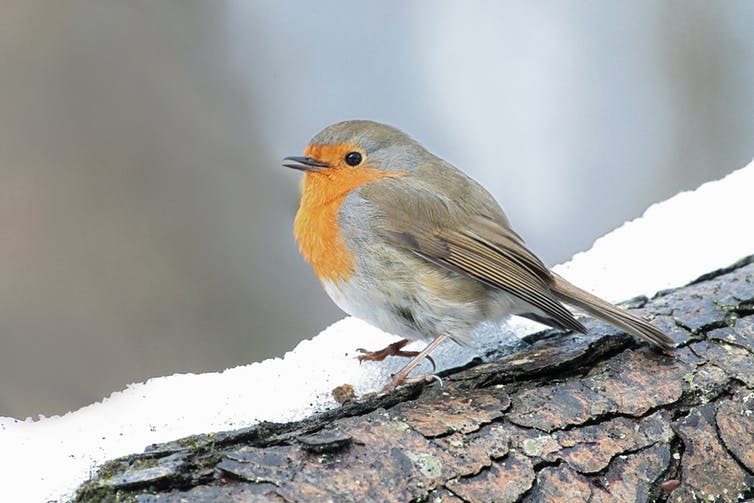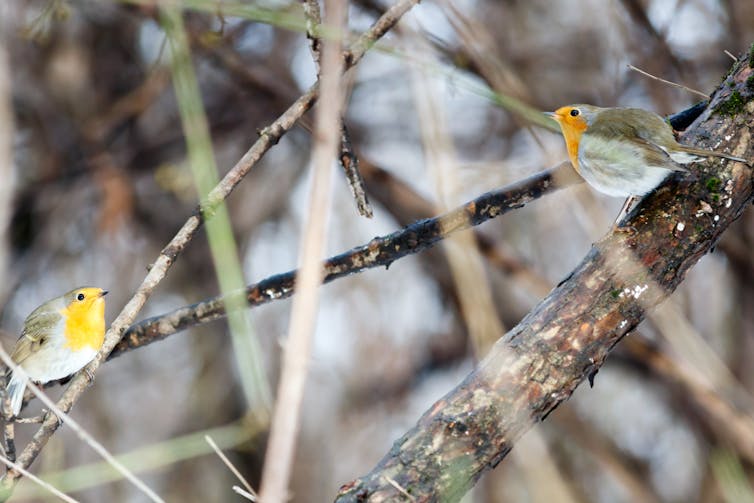 Roman Teteruk/Shutterstock
Roman Teteruk/Shutterstock
Mark Whittingham, Newcastle University
Wind turbines are a leading source of green energy which could supply 12% of the world’s energy by 2020. But their use is often criticised for its impact on wildlife, particularly birds. Larger birds can collide with turbines and some have even learned to avoid flying near them.
Impacts on smaller birds are less well documented as they tend to manoeuvre around turbines and can avoid impacting with them much more easily than larger species. My own research showed that birds associated with farmland, including a range of songbirds, were generally unfazed – their winter distribution didn’t change in the presence of turbines.
But there were also some intriguing patterns in the behaviour of skylarks in early spring. We noticed their numbers were generally lower close to turbines. I wondered then whether the noise emitted by the turbines might be responsible.

Maradon 333/Shutterstock
Wind turbines and songbird communication
Much of the evidence for how wind turbines affect birds concerns their distribution patterns around turbines, but we know little about why birds choose to avoid them. The robin, a widespread small bird which lives in rural areas where turbines are common, seemed a perfect candidate to investigate.
Robins are an aggressive but popular species in the UK, having recently been voted the nation’s favourite bird. Males are territorial beyond proportion to their diminutive size. Nevertheless, we subjected territorial male robins to one of three treatments – another robin’s song, a robin’s song with wind turbine noise, and wind turbine noise alone – via a sound recording device inside their territory.
Robins defending their territory typically respond to an intruder by increasing the proportion of low frequency sounds in their songs. We found that the robins subjected to robin song and wind turbine noise simultaneously had significantly fewer low frequency elements in their songs and so their songs sounded higher pitched. We interpreted this as interference from the wind turbine noise which occurs at low frequencies.
It’s suspected that lower frequency noises make the robin singer “sound” bigger and thus reduce the need for more direct physical encounters to defend their territory. But with the low frequency sound emitted by wind turbines drowning them out, there was a suggestion that robins were having to rely more on puffing out their red chest to deter aggressors.

Vishnevskiy Vasily/Shutterstock
Reconciling wind energy with wildlife
That may be why breeding songbirds, such as the skylark, avoid turbines. Recent work has found breeding bird populations such as the Dupont’s lark, a near-threatened species of songbird found in North Africa and Spain, declined in areas with wind turbines.
The underlying reason may be, at least partially, that birds avoid noisy habitat that makes communication more difficult. Another study looked at the long-term impact of noise from generators in a forest, and showed how it reduced territory quality for ovenbirds, a common warbler with a complex and beautiful song from the Americas.
Read more:
Wind turbines aren’t quite ‘apex predators’, but the truth is far more interesting
The impact of wind turbines on birds goes beyond the risk of direct collision or avoidance. Noise emitted from turbines could disrupt their communication and leave them vulnerable. This is particularly troubling when we consider that wind turbines are often located in remote areas, some with high densities of songbirds, such as meadow pipits and skylarks in upland areas of the UK.
Of course, it is important to remember the bigger picture. While wind turbines may harm birds nearby, renewable energy is a vital solution to climate change – perhaps the most pressing threat to biodiversity globally.
Nevertheless, noise pollution from wind turbines should be measured during environmental impact assessments of wind energy projects, to ensure effects on the surrounding wildlife are minimised. That way, the robin and other songbirds might hope for more peaceful Christmases in future.![]()
Mark Whittingham, Professor of Applied Ecology, Newcastle University
This article is republished from The Conversation under a Creative Commons license. Read the original article.





 B
B
26 Comments
Pingback: สล็อตเว็บตรง 2023
Pingback: ทำสติ๊กเกอร์
Pingback: HUAYYIM เว็บแทงหวยยิ้ม
Pingback: https://www.adventistchurchconnect.com/forwarder/part1?url=https://gasdank.com/
Pingback: เว็บมวยราคาดีที่สุด
Pingback: ks quik
Pingback: visit site
Pingback: หาฤกษ์ผ่าตัด
Pingback: แทงมวยกับ LSM99 อัตราจ่ายเยอะ กำไรชัวร์
Pingback: thailand tattoo
Pingback: 꽁머니환전
Pingback: ราคาบอล 4 ตังค์ มีความหมายอย่างไร
Pingback: บุญมี สล็อต
Pingback: เสริมจมูก พัทยา
Pingback: Event venue phuket
Pingback: PG SLOT จ่ายจริง ตัวคูณโหด
Pingback: mkx gummies near me
Pingback: Lsm11 คาสิโนเว็บตรง ฝากถอนออโต้
Pingback: ทำความรู้จัก AMB999 ฝาก-ถอน ออโต้
Pingback: โคมไฟ
Pingback: webcam chat
Pingback: fear of god essentials
Pingback: psu for gaming hyderabad
Pingback: massage Bangkok
Pingback: Buy Wyld Elderberry Gummies
Pingback: เช่ารถเครน